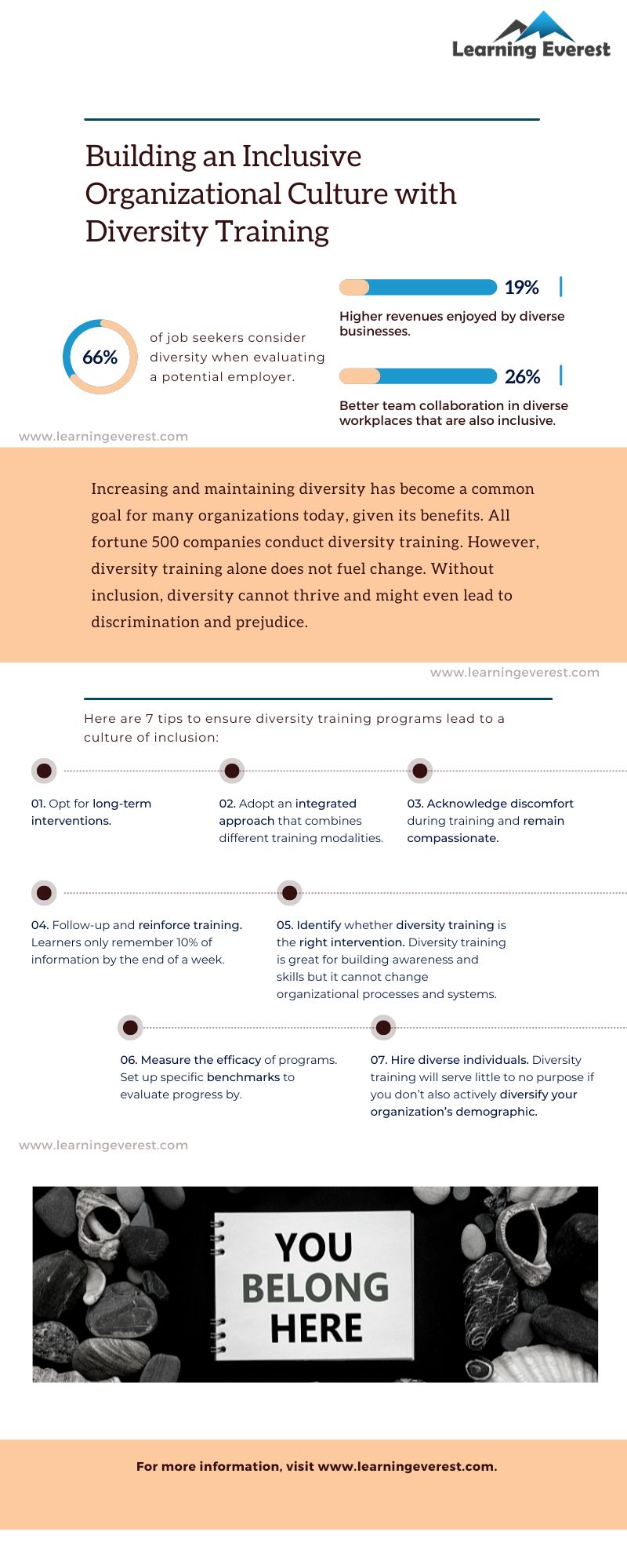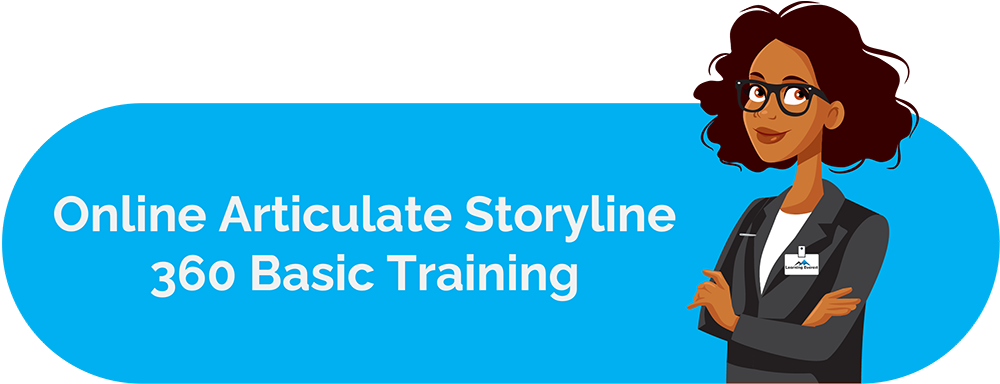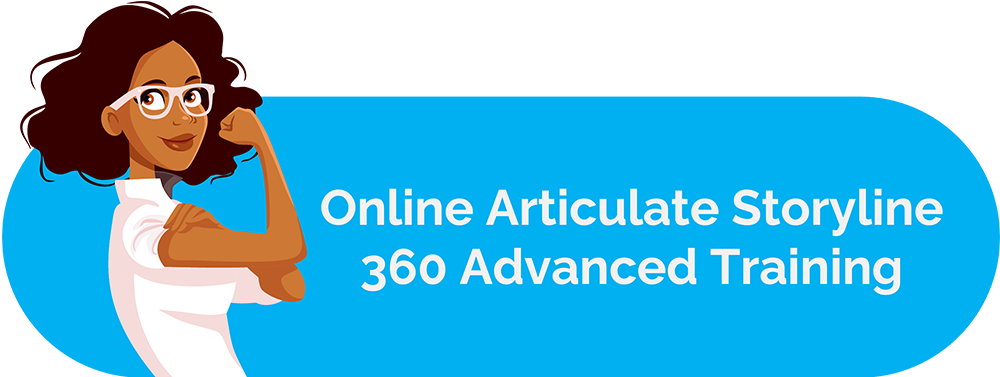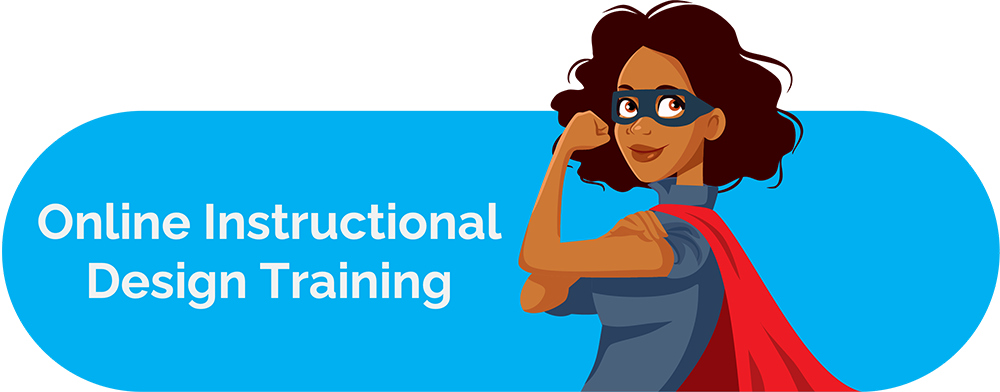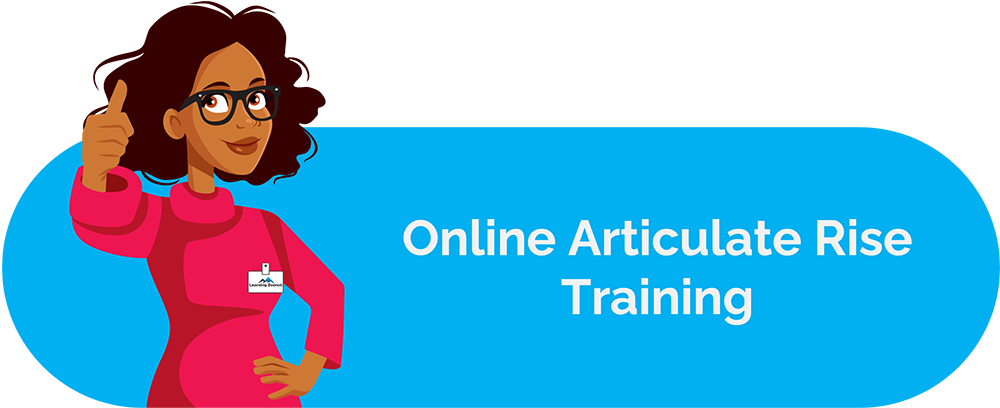It’s common for businesses today to build an inclusive organizational culture by offering diversity training to their workforce. According to HBR, all Fortune 500 companies conduct diversity training. There is also widespread awareness about the many benefits of diverse workplaces from greater innovation to better market performance.
Table of Contents
However, diversity training alone does not fuel change. Rather, it is one of the many mechanisms that create an inclusive organizational culture. Without inclusion, diversity cannot thrive and might even lead to discrimination and prejudice. In contrast, a diverse and inclusive business is a powerhouse.
Diversity along with inclusion improves team collaboration by 26% and team commitment by 18% (Source: Gartner).
In this article, you will find 7 tips that will help you maximize the effectiveness of your diversity training programs to build an inclusive organizational culture.
Tip 1 for Inclusive Organizational Culture: Opt for Long-Term Interventions
In a review by Bezrukova, et al. (2016), it was found that standalone diversity training sessions do not have a long-lasting impact on learners. While they might affect learners’ attitudes, beliefs, and behaviors in the short term, learners tend to revert to their older thinking patterns and worldviews a few weeks after short-term interventions.
If a business’ main aim is an inclusive organizational culture, it requires a more sustainable approach. Long-term interventions provide this sustainability, producing longer-lasting changes in learners.
Instead of squeezing topics into a one-day session or a three-hour-long workshop, businesses can adopt a modular approach. This way, you also get to cover a richer curriculum through the course of the intervention.
To make these long courses easier to digest, you can convert them into self-paced microlearning modules and make them readily available on your company LMS.
Tip 2 for Inclusive Organizational Culture: Adopt an Integrated Approach
Diversity training is more impactful when it uses multiple training strategies, i.e., an integrated approach. An integrated approach combines different training modalities such as lectures, mentoring, videos, group activities, community interactions, etc.
By doing so, you give learners a more holistic understanding of the experiences of those different from them. Multidimensional approaches also provide various avenues for internal reflection which can be a powerful driver of self-motivated internal change.
Naturally, the rigor of an integrated diversity training approach will help build an inclusive organizational culture instead of producing surface-level changes.
Tip 3: Acknowledge Discomfort and Remain Compassionate
Diversity training often causes learners to face difficult things about themselves. This can often be an uncomfortable journey for them.
If diversity training is framed to only educate majority groups, this discomfort can feel even more pronounced.
This can become a challenge to your efforts to build an inclusive organizational culture and, thus, should be mitigated.
Some things that can make this process easier for learners to come to terms with and learn from are:
- Focus on empathy and perspective building instead of highlighting differences directly
- Remind learners that it is okay to feel uncomfortable and conflicted and validate that it is part of the process
- Avoid mentioning the legal consequences of biases and prejudice
- Appeal to learners’ internal motivation
- Along with building awareness, also give learners concrete strategies to exercise inclusion to further motivate them
When you include tools to mitigate discomfort and resistance within your diversity training curriculum, you are effectively increasing the likelihood of long-lasting change in learners. This change will go a long way in creating an inclusive organizational culture for your business.
Tip 4 for Inclusive Organizational Culture: Follow up and Reinforce Training
An inclusive organizational culture cannot be created without reinforcing diversity training. Human brains are wired to forget as much as 70% of new information in the first 24 hours of learning it. By the end of a week, they can only recall 10% of it effectively.
Thus, if diversity training is delivered and then never revisited, it won’t change learners’ behaviors for the long run. Businesses should follow up on their training programs with revision materials and reminders. Some tips for reinforcing learning are:
- Microlearning
- Gamified activities
- Infographics
- Emails and messages
- Pop-ups within the flow of work
Tip 5: Identify Whether Diversity Training is the Right Intervention
While diversity training is indispensable in your strategy for building an inclusive organizational culture, some issues might need a different solution.
Diversity training is great for building awareness and skills but it cannot change organizational processes and systems.
Thus, for such goals, you’ll need different interventions such as setting up new policies, training managerial staff, and other such structural changes at the top levels of the organization.
Similarly, you’ll need to identify whether diversity training on its own will be sufficient to meet your objectives or whether a multidimensional intervention will be better.
Tip 6 for Inclusive Organizational Culture: Measure the Efficacy of Programs
If you don’t measure how your diversity training programs are affecting organizational culture, all training efforts will be as good as wasted.
To ensure that a certain intervention does indeed lead to an inclusive organizational culture, you will need to set up specific benchmarks to measure the effects of diversity programs.
To do so, you’ll have to begin with framing SMART goals or objectives. SMART is an acronym that stands for:
- Specific
- Measurable
- Achievable
- Relevant
- Time-bound
An easy way to write smart learning objectives is to stick to a single goal per objective. That adds specificity.
Measurability is the most important aspect for the eventual evaluation of a program’s efficacy. Some ways to make goals measurable are:
- An increase or decrease in pre-test and post-test scores
- An increase or decrease in the percentage of a certain dimension
- An increase or decrease in the number of certain incidents
- An increase or decrease in the frequency of specific behaviors
To make learning objectives achievable, you will need to evaluate your learners’ current level of familiarity or expertise with the topic. Naturally, this will vary from organization to organization.
Relevance refers to whether a goal contributes to your end target. Breaking it down into smaller steps can help you come up with relevant learning objectives.
Lastly, you can specify a time limit for achieving learning objectives. If your learners do not show the expected level of change or improvement by the end of this time frame, you will have an additional indication of the efficacy of your program.
Tip 7: Hire Diverse Individuals
This tip is not directly related to diversity training but is imperative for creating an inclusive organizational culture.
As part of your inclusion efforts, you will also need to look into hiring practices. This is because diversity training will serve little to no purpose if you don’t also actively diversify your organization’s demographic. Additionally, it will let employees know that diversity and inclusion efforts are also being carried out at the top levels of the organizations.
Knowing that this is an organization-wide effort will make it seem like less of an obligation and more of a value shift everyone is on board with.
Working with diverse individuals will also give your employees more exposure and help them get to know different people personally. This can create opportunities for meaningful and long-lasting change as interacting with people from different communities is one of the best ways to develop empathy and relatability.
Infographic
Conclusion
Building an inclusive organizational culture is a goal that requires prolonged and organized effort. Diversity training is one of the many tools at an organization’s disposal, however, it cannot be the only solution. Within a more comprehensive diversity and inclusion framework, however, diversity training can add immense value, especially when it is multimodal, spans over a long time, is measured, and is reinforced from time to time. Additionally, e-learning strategies can greatly aid businesses in their journey to create an inclusive organizational culture.
Frequently Asked Questions (FAQs)
Why is an inclusive organizational culture needed?
It’s common for businesses today to offer diversity training to their workforce. However, diversity training alone does not fuel change. Rather, it is one of the many mechanisms that create an inclusive organizational culture. Without inclusion, diversity cannot thrive and might even lead to discrimination and prejudice. In contrast, a diverse and inclusive business is a powerhouse. For instance, diversity along with inclusion improves team collaboration by 26% and team commitment by 18%.
How can e-learning contribute to an inclusive organizational culture?
E-learning has many tools that can be used in diversity training, such as:
- Microlearning
- Gamified activities
- Infographics
- Emails and messages
- Pop-ups within the flow of work
What is the role of diversity training in an inclusive organizational culture?
Within a more comprehensive diversity and inclusion framework, diversity training can add immense value to a business’s journey to inclusivity when it is multimodal, spans over a long time, is measurable, and is reinforced from time to time.
Sources
- https://www.gartner.com/smarterwithgartner/diversity-and-inclusion-build-high-performance-teams
- https://insight.kellogg.northwestern.edu/article/improve-diversity-training
- https://hbr.org/2019/07/does-diversity-training-work-the-way-its-supposed-to
- https://rrapp.hks.harvard.edu/diversity-training-has-transformative-potential/


